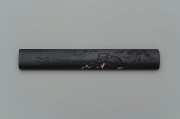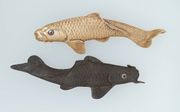Difference between revisions of "Shibuichi"
Jump to navigation
Jump to search
m (Text replace - "\[http:\/\/cameo\.mfa\.org\/materials\/fullrecord\.asp\?name=([^\s]+)\s(.*)\]" to "$2") |
|||
| Line 1: | Line 1: | ||
| − | [[File:37.973-SC61952.jpg|thumb|]] | + | [[File:37.973-SC61952.jpg|thumb|Kozuka<br>MFA# 37.973]] |
== Description == | == Description == | ||
| − | + | [[File:11.5268a-SC61430.jpg|thumb|Menuki<br>MFA# 37.973]] | |
A Japanese term for decorative [[copper|copper]] alloy containing 15 or 25 % [[silver|silver]]. Shibuichi is often etched or stained to produce blue or green color variations. Swordmakers used shibuichi for ornamental fittings. | A Japanese term for decorative [[copper|copper]] alloy containing 15 or 25 % [[silver|silver]]. Shibuichi is often etched or stained to produce blue or green color variations. Swordmakers used shibuichi for ornamental fittings. | ||
| − | == | + | ==Resources and Citations== |
| − | |||
| − | |||
| − | |||
| − | |||
| − | |||
| − | |||
| − | |||
| − | |||
| − | |||
| − | + | * Reactive Metals Studio: [http://www.reactivemetals.com/Data_Instructions/ShiningWave/d_ShakShibu.html Data sheet: Shakudo and Shibuichi] | |
* David C. Scott, ''Metallography and Microstructure of Ancient and Historic Metals'', The Getty Conservation Institute, Los Angeles, 1991 | * David C. Scott, ''Metallography and Microstructure of Ancient and Historic Metals'', The Getty Conservation Institute, Los Angeles, 1991 | ||
Revision as of 14:57, 30 May 2022
Description
A Japanese term for decorative Copper alloy containing 15 or 25 % Silver. Shibuichi is often etched or stained to produce blue or green color variations. Swordmakers used shibuichi for ornamental fittings.
Resources and Citations
- Reactive Metals Studio: Data sheet: Shakudo and Shibuichi
- David C. Scott, Metallography and Microstructure of Ancient and Historic Metals, The Getty Conservation Institute, Los Angeles, 1991

